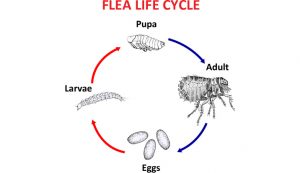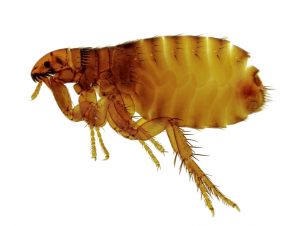Identification and Life Cycle
The more common type of flea is the cat flea, Ctenoephalides felis. Fleas occur on both cats and dogs and will bite humans and other animals. These parasites live on a host and will pierce the skin and suck the blood to feed.
Adult fleas are very small, about 1/8 – inch long, and dark brown in color. They are wingless insects with a vertically flattened body that enables them to move easily through body hairs. They have well-developed long back legs for jumping as high as 16- inches.
Fleas have four stages of metamorphosis; egg, larva, pupa, and adult. The adult flea spends most of its time on the host, and lays eggs on either the pet, in the pet’s bedding, or in cracks and crevices of floors. The attached eggs soon fall off because they are not sticky, and can end up in carpeting, upholstered furniture, or in the pet’s bed. The larvae are wormlike and white in color. They feed on dried blood and excrement left by the adult. In about 12 days, the larvae is fully grown and change to the pupal stage (pupae are inactive and do not feed). The pupae stage can last from one week to a year depending on its environment before changing to an adult.





Comments are closed.